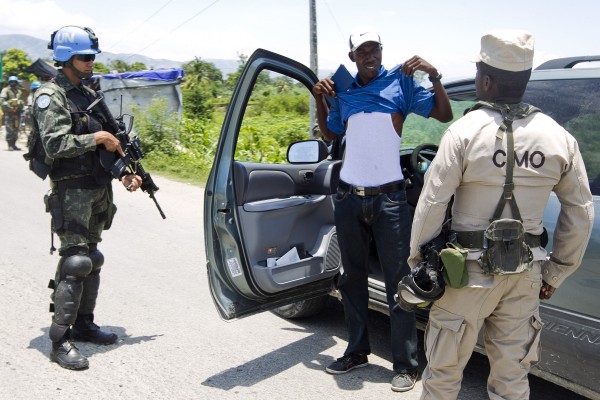
Brazilian UN peacekeepers support Haitian police during a car search. Haitian National Police, in coordination with police and military from the United Nations Mission in Haiti (MINUSTAH) established country wide security check points in search of illegal weapons. Photo: Logan Abassi UN/MINUSTAH
Given Mexico’s ongoing campaign against the narco-gangs and Colombia’s omnipresent civil war, it is not surprising that defense budgets are ballooning across Latin America. According to a report by Rachel Glickhouse of the Americas Society/Council of the Americas and data from the Stockholm International Peace Research Institute (SIPRI; see links below), Latin American countries spent $73 billion on their militaries in 2011. Defense funds grew 5.3% annually in real terms on average between 2003 and 2011. An examination of individual countries’ priorities shows a pattern focused on capabilities that can contain traditional intrastate conflict while simultaneously providing a platform to project power externally.[1]
Existence of national military threats in the region seems murky. Brazilian Defense Minister Celso Amorim recently stated his goal to “react or dissuade any effort to invade our territory.” Brazil and Colombia do have a common priority in patrolling the Amazon against drug trafficking and illegal timber harvesting, and will perform this duty together. Brazil also maintains the military backbone of the longstanding, but little recognized, United Nations Stabilization Mission in Haiti (MINUSTAH). MINUSTAH’s Force Commander is Major General Fernando Rodrigues Goulart, an experienced UN peacekeeper.[2]
The Brazilian plan eliciting the most questions is the government’s effort to develop five nuclear submarines. Ostensibly to protect the country’s massive offshore oil fields, some wonder if an ulterior motive is at work, such as support for Argentina in the Falklands controversy. However, Brazil’s naval expansion does reflect similar projects by its regional neighbors, primarily in air power.
One example further west is Chile. Chile will massively upgrade its air force and hopes to acquire the Israeli Hermes 900 drone aircraft to patrol its coastline of over 4,000 miles. Meanwhile, Peru’s priorities are eradicating coca and dealing with a resurgent Shining Path rebel group. Peru spent about $2 billion on defense in 2011, up 32% since 2008. Jet fighters and transport planes manufactured by Canada’s Viking Air and South Korea’s Korea Aerospace Industries became main targets. A true wild card is Venezuela, who cannot purchase arms from the US and its allies. Venezuela imports from Russia, China, and Iran, though its military budget has swung wildly in the past few years. Venezuela’s arms plans are also tilted skyward. According to Flight Global Americas Managing Editor Stephen Trimble, “if all come to fruition, Venezuela could boast the most powerful air force in South America.”[3] In this context, Brazil’s submarines may have the double purpose of responding to neighbors building their strike capability and protecting the seaborne oil rigs.
So then, how can the US ride this wave as a positive influence? Fortunately, we are beyond the age of direct aid to dictatorships like those of Brazil’s military government or Alfredo Stroessner in Paraguay. The Merida Initiative and Plan Colombia have assisted the Mexican and Colombian Governments against drug trafficking, and serve as successful templates in the case of specific conflicts. As part of Merida, Congress has appropriated about $1.6 billion since 2008 to train police officers, develop the justice system, and provide equipment such as helicopters. While Mexico’s leaders have complained that the US is slow to disburse aid, they must be grateful — according to SIPRI, Mexico is one of the lowest military spenders in the region as a percentage of GDP (0.5%).[4]
To support Colombian President Andres Pastrana in 1998, President Clinton pledged a similar aid figure. The Plan Colombia trained special military counter-narcotics battalions and provided equipment to combat the FARC while promoting NGO’s that spread human-rights awareness. Police received anti-kidnapping and anti-money laundering acumen. Pastrana’s government could provide humanitarian assistance for 300,000 people displaced by civil war in the late 90’s.
Public support in Latin American nations for bilateral military cooperation with the US may not be so strong in absence of conflict. However, the civil society measures described above (judicial reform, strengthening of NGOs, humanitarian assistance) may be the right path. Chile has recent natural disaster experience, and Peru a smoldering, if withering, insurgency. At least the US does have a successful calling card – Colombia is auctioning mineral exploration rights to land retaken from the FARC.
[1] http://milexdata.sipri.org/files/?file=SIPRI+milex+data+1988-2011.xls; SIPRI Insights on Peace and Security. No. 2011/2, December 2011.